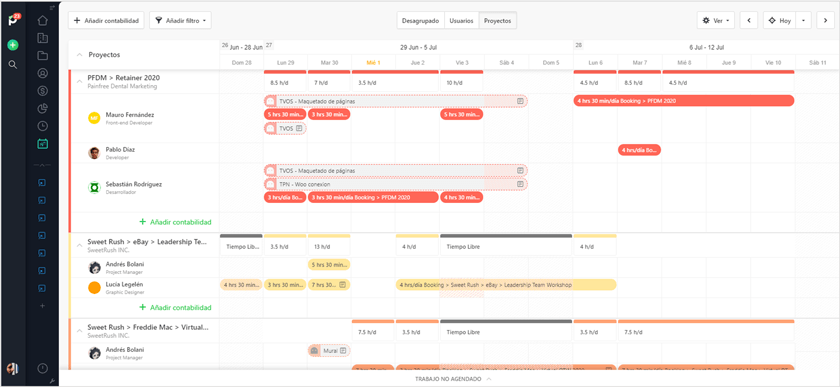🌻 Summer Special Offer - Save up to 40% on your first 3 months with Paymo!
Check plans and prices
CUSTOMER STORY
Ameba Creative Studio Puts Brands On The Map With Paymo
with  Miguel Vallvé, CEO & Co-founder
Miguel Vallvé, CEO & Co-founder

COMPANY
Ameba Creative Studio
LOCATION
Montevideo, Uruguay
INDUSTRY
Creative Agency



COMPANY
Ameba Creative Studio
LOCATION
Montevideo, Uruguay
INDUSTRY
Creative Agency
40
Projects/month
11
EMPLOYEES
5
YEAR USING PAYMO
All for one and one for all
The chances of getting a job right out of university are pretty slim. Especially if you’re a graphic design student.
That’s how Miguel Vallvé, Fabricio D’Agata, Lucía Martínez and five other university friends put their portfolios together to form Ameba Creative Studio in 2009, to search for freelance gigs while finishing their degrees. Two years later, with very few real projects done, Miguel and Fabricio decided to take the leap and rent a small office in downtown Montevideo, Uruguay. As Miguel recalls:
This was pretty important as it was the first time we were actually assuming fixed costs and at the end of the day, just 3 out of the former 8 decided to continue in Ameba.
Since then, Ameba has grown into Uruguay’s leading creative studio, specializing in shaping stories that sell to brands from the US and Europe, through a user-centric approach.
Learning the ropes
Looking back to 2011, Miguel recalls their first international client who introduced them to their first project management software: Wrike. This was a huge jump from spreadsheets.
They continued to use Wrike for more than three years, up until the tool changed their pricing model and went “too high and absurd” for their budget. The quest for a replacement started, but none of the tested tools—Trello, JIRA, Teamwork, Basecamp, Freshworks, ClickUp, nor Monday.com—matched their needs in full. The urgency to change their work management tool was even more pressing, given that they had lost an important client at that time as well:
We had a dream client that meant 90% of our profit. When our paths split, we had to be able to manage small and multiple clients at the same time. Paymo helped us to keep a high-level overview of the projects and learnt which projects were hurting us and which were more valuable.
What made Paymo appealing for Miguel was the smooth integration between project and business management – the ability to see costs, invoices, and team schedules in one place, while making sure projects are on track. Usability was also an important aspect, as he confesses:
We had to migrate everything from Wrike, so I guess it took us about 2 months to do so. However, to understand the tool and start using it with new clients—one week. We are still changing and learning how to get the best out of it.
Because of this, the transition process was all about being hands-on and letting people be accountable for their own areas of expertise:
The first was to emulate what we do in real life with a process or piece of data in Paymo. We modeled the best we could and wrote some processes for everyone. Each person took ownership of their area. For instance, the project managers created the flow about how to set a project.

Miguel Vallvé, CEO & Co-founder @AmebaCreativeStudio
Putting brands on the map
Going beyond the adoption phase, the team now uses Paymo as a way to learn what’s going on company-wide from a sales, human resources, and project management perspective.
The Team Scheduler allows them to understand whether they have enough capacity for an upcoming project (sales) or need to hire extra freelancers (HR). The leave days—which are visible on the scheduler too—in combination with the % of performance serve as cost and payroll calculator (HR). While the actual time tracked vs. the estimated hourly budget at a task list level helps with identifying which stages of the project have been underquoted (PM).

Team Scheduler in Paymo
As for Miguel, he mastered time reports at a level that gives him the flexibility to make sound business decisions, with the overall project costs and margins in clear sight.
We use reports company-wide and for the most varied purposes. We got cost reports based on team members' hourly rates that are created when the projects are closed or every 3 months for the retainers. Then we have live-client-facing reports that we share so everyone can keep track of what is going on with the projects and acknowledge the impact of changes. Finally, we track non-billable, internal, and client work to get a big picture of the company's capability.
Back to the present, the small group of university friends has come a long way from renting a small flat in downtown Montevideo to creating well-shaped brand stories for new startups and well-known companies such as Petrobras, Vespa, Bimbo Bakery Group, and The Central Bank of Uruguay. To put it in Miguel’s words:
Without Paymo, I wouldn't have been able to scale my business and would probably be doing more production work instead of business development.
Explore used features
Help your team work better.
Try Paymo.
Resources
Project Management GuidePM Software for CreativesPM Software for ArchitectsKanban SoftwareProject Management SoftwareBest Time Tracking SoftwareEmployee Time Tracking SoftwareTime Tracking Software for ConsultantsFree Invoicing SoftwareTask Management SoftwareTimesheet SoftwareResource Management SoftwareGantt Chart SoftwareTime Tracking AppsHow to Become a Project ManagerProject TrackerHow to Increase ProductivityProject Management MethodologiesCopyright © 2025 Paymo LLC
By signing up, you're agreeing with the Paymo Terms of Service and Privacy Policy
Cookies help us deliver our services. By continuing to use the website, you consent to the use of cookies.
Learn more about the cookies in Our Privacy Policy.

 Desktop App
Desktop App Mobile App
Mobile App Integrations
Integrations






